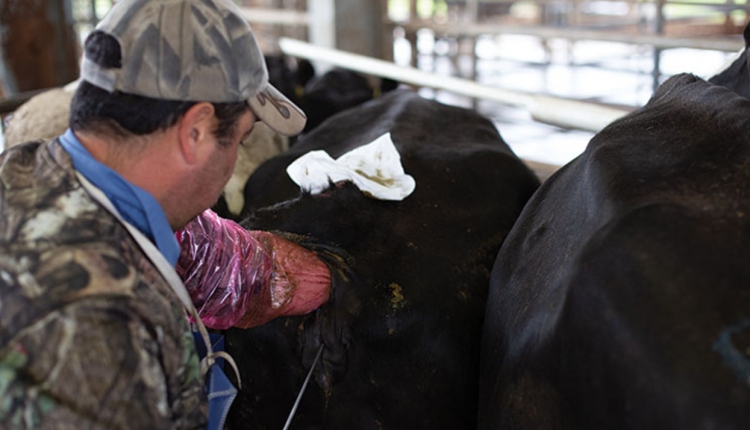At our most recent Dairy Cattle Reproduction Council meeting, the University of Guelph’s Stephen LeBlanc gave an excellent presentation highlighting the importance of monitoring ketosis in transition cows.
Ketosis occurs when blood concentrations of ketone bodies (beta-hydroxy butyric acid or BHBA, acetone, and acetoacetate) are elevated in the blood. Ketone bodies become elevated when the liver is unable to completely oxidize or “burn” fatty acids that are released from fat stores. For the dairy cow, this occurs during early lactation when she mobilizes fat to support milk yield in the face of inadequate feed intake.
Clinical ketosis is evident through visible signs. This includes reduced milk yield, depressed feed intake, dry manure, and rapid loss of body condition. Clinical ketosis may occur by itself or in the presence of another disease. For example, cows with a displaced abomasum also commonly have ketosis. Time of diagnosis of the disease does not necessarily equate to its onset. For example, subclinical ketosis commonly precedes the diagnosis of a displaced abomasum.
Cows with clinical ketosis typically have blood BHBA greater than 2.5 mmol/L, but this is variable, and no clear threshold exists in which clinical signs occur. Clinical ketosis at best represents the “tip of the iceberg” because many cows may have subclinical ketosis, which is a condition without outward physical signs, but where blood ketone concentrations are above a threshold. Depending on the outcome in question and the stage of lactation, the threshold for subclinical ketosis is blood BHBA greater than 1.1 to 1.4 mmol/L.
Disease prevalence
Several large studies indicate that, on average, more than 40 percent of cows experience ketosis at least once during the first two weeks after calving. Even in very well-managed herds, 10 percent incidence is common.
Subclinical ketosis occurs in the range of 15 to 20 percent in most herds. Depending on the severity and timing of its onset, ketosis may reduce milk yield during early lactation. Aside from its potential ill effects on milk yield, subclinical ketosis (BHBA greater than 1.2 to 1.4 mmol/L) during the first or second week after calving is associated with:
- Three to eight times greater risk of displaced abomasum
- Three times greater risk of metritis when blood BHBA during Week 1 was greater than 1.2 mmol/L
- Four to six times increased risk of clinical ketosis
- Greater probability of subclinical endometritis during Week 4 of lactation
- Increased duration and severity of mastitis but not the incidence of mastitis
- 1.8 times greater likelihood of culling before 60 days in milk
Tougher on reproduction
Ketosis is associated with reduced reproductive performance, which extends its impact much longer than many realize. Health during the weeks before and after calving influences reproductive traits for at least two months after. Cows that experienced ketosis during the first two weeks of lactation had reduced probability of pregnancy at the first insemination.
Subclinical ketosis (serum BHBA greater than 1.0 to 1.4 mmol/L) during early lactation is associated with:
- Three times greater risk of metritis
- 1.4 times greater risk of endometritis (uterine inflammation based on cytology) at 35 days in milk
- 1.5-fold additional risk of being anovular (not cyclic) at 63 days in milk
- Reduced pregnancy rate at first A.I.

Detection can help
Accurate, practical, and economical cowside tests are available to detect ketosis in blood, milk, or urine (see table). Most herds would benefit from a routine ketosis screening and treatment program administered once or twice weekly.
Few management practices or interventions exist that can specifically prevent ketosis. A large part of the controllable variation lies at the herd or management level, including bunk space and feed availability, movement and grouping, heat abatement, feed quality, TMR consistency, water access, and where approved, use of monensin controlled-release capsules (Rumensin).
Cows with ketosis should be treated with 300 mL propylene glycol by drench once daily for three to five days and then retested the day after the last treatment. Based on cure of ketosis and production responses, conclusions of several studies for treatment were:
If blood BHBA greater than or equal to 1.2, but less than 2.4 mmol/L, treat with propylene glycol for three days.
If blood BHBA greater than 2.4 mmol/L, treat with propylene glycol for five days.
If blood BHBA greater than 1.2 mmol/L and glucose less than 2.2 mmol/L, also include treatment with Catosal (BayerDVM; source of vitamin B12 and phosphorus) for three days to either of the previous propylene glycol recommendations.
Management practices generally recommended for transition dairy cows are likely to contribute to prevention of ketosis and to better reproductive performance. Fortunately, these “transition diseases” such as ketosis are largely inter-related — reducing the incidence and severity of one disease usually reduces the incidence and severity of others. Happy A.I. breeding!










